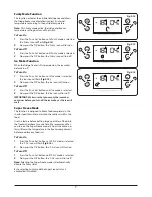
14
Tips on Freezing Food
•
As with storing fresh foods, suitable packaging, correct
temperature and food hygiene will enhance the quality
of the food you are freezing.
•
Avoid putting hot foods into the freezer. First let them
cool until they reach room temperature.
•
Make sure that all foods for freezing are of a high
quality, and suitable for freezing.
•
Use packaging material that is odourless and airproof
(such as plastic bags) to store food in so different foods
can be mixed without affecting the quality. Make sure
that it is airtight. Leaking packaging will dehydrate the
products and lead to loss of beneficial vitamins.
•
Keep the surface of the packaging dry – this keeps the
packs from freezing together.
•
Mark packages with the kind of food contained and the
date of storage.
•
Food needs to be frozen quickly, so it is best to
freeze small portions whenever possible and ensure
that they are as cold as possible before storage. The
recommended maximum weight for each portion is
2.5 kg.
•
Keep food which is fresh away from food which is
already frozen, if you need to freeze fresh food every
day, make sure that it is in small portions to prevent this.
•
Do not exceed the maximum load for freezing – which is
given as 10 kg / 24-hours (see data badge for details).
•
Write the expiry date and food names on the outside of
the packaging so you can be assured of the food type
and when it is safe to eat.
•
Take food from the freezer to defrost when needed.
Defrosted food cannot be refrozen unless it is cooked.
•
Do not put too much fresh food into the freezer at once.
This could go beyond the freezer’s cooling capacity (see
‘Technical Data’
).
When storing commercially frozen foods, please follow these
guidelines:
•
Always follow manufacturers’ guidelines for the length
of time you should store food for. Do not exceed these
guidelines!
•
Try to keep the length of time between purchase and
storage as short as possible to preserve food quality.
•
Buy frozen foods, which have been stored at a
temperature of –18 °C or below.
•
Avoid buying food which has ice or frost on the
packaging – This indicates that the products might have
been partially defrosted and refrozen at some point –
temperature rises affect the quality of food.
•
Should there be a power cut, or the freezer /
refrigeration appliance fail for any length of time you
may need to remove food from the freezer and store
in a cold, hygienic place (i.e. garage or out house area)
until the power is restored, or the appliance is repaired.
•
To prevent undue temperature rises you should wrap
the foods in layers of insulating material, such as
newspaper, to help to maintain their temperature. It is
also important that any food affected by this situation
should be either consumed or cooked and refrozen
(where suitable) soon afterwards in order to prevent
health risks.
•
Layers of newspaper can also be used to help keep
foods cold while you are defrosting the freezer (see
‘Cleaning and Maintenance’
).
Содержание DxD 15
Страница 1: ...DxD 15 Refrigerator User Guide Installation Service Instructions U110466 01B...
Страница 23: ...21 Notes...










































